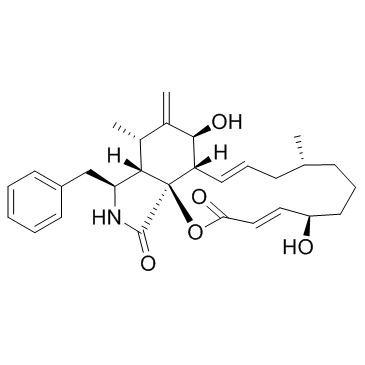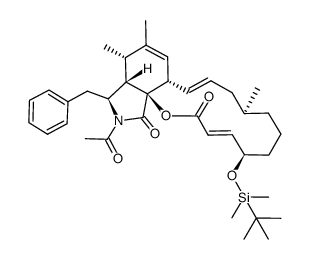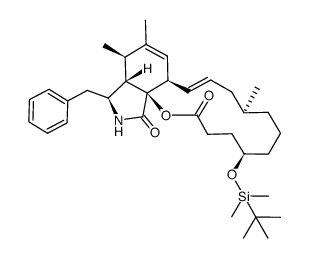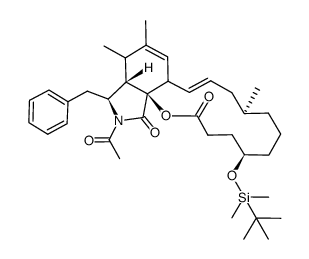14930-96-2
| 中文名 | 细胞松弛素B |
|---|---|
| 英文名 | cytochalasin B |
| 中文别名 | 细胞松弛素 B |
| 英文别名 |
EINECS 239-000-2
(3E,5R,9R,11E,12aS,13S,15S,15aS,16S,18aS)-16-Benzyl-5,13-dihydroxy-9,15-dimethyl-14-methylene-6,7,8,9,10,12a,13,14,15,15a,16,17-dodecahydro-2H-oxacyclotetradecino[2,3-d]isoindole-2,18(5H)-dione Phomin (3E,5R,9R,11E,12aS,13S,15S,15aS,16S,18aS)-16-benzyl-5,13-dihydroxy-9,15-dimethyl-14-methylidene-6,7,8,9,10,12a,13,14,15,15a,16,17-dodecahydro-2H-oxacyclotetradecino[2,3-d]isoindole-2,18(5H)-dione Cytochalasin B MFCD00077704 |
| 描述 | Cytochalasin B 是一种能透过细胞的真菌毒素,能够与肌动蛋白丝的有刺端结合,扰乱肌动蛋白聚合物的形成,对 F-actin 的 Kd 值为 1.4-2.2 nM。 |
|---|---|
| 相关类别 | |
| 靶点 |
Kd: 2.2 nM (F-actin, with Mg2+), 1.4 nM (F-actin, with Mg2+/K+)[1] |
| 体外研究 | 细胞松弛素B是一种细胞可渗透的霉菌毒素,与肌动蛋白丝的带刺末端结合,抑制肌动蛋白丝的延长和缩短,在MgCl2(2 mM)或MgCl2存在下,F-actin的Kds为2.2 nM和1.4 nM(分别为2 mM)和KCl [1]。细胞松弛素B(0.1-10μM)对多种小鼠癌细胞系均有抑制作用,IC50分别为2.56μM(M109c),10.46μM(B16BL6),105.5μM(P388/ADR),51.9μM(P388/S)和IC80s处理3 h后,12.23μM(M109c),44.86μM(B16BL6),188.4μM(P388/ADR),84.1μM(P388/S),IC50为0.25μM(M109c),0.37μM(B16F10),0.87处理4天后,μM(B16BL6)和0.80μM(M109c),1.21μM(B16F10),10.41μM(B16BL6)的IC80s [2]。细胞松弛素B(6μM)增加了肌原纤维碎裂指数(MFI),这是由于肌原纤维蛋白强烈分裂成短片段。细胞松弛素B还加速肌动蛋白丝的破坏。此外,细胞松弛素B加速了从F-肌动蛋白到G-肌动蛋白的转化,降低了F-肌动蛋白的含量,并在死后调理过程中显着增加了G-肌动蛋白条带[3]。 |
| 体内研究 | 细胞松弛素B(10,25,50mg/kg,ip)剂量依赖性地增加携带P388/ADR白血病的Balb/c小鼠的预期寿命。 50mg/kg的细胞松弛素B在多药耐药P388/ADR组中产生10%的长期存活率,在药物敏感的P388/S组中产生40%的长期存活[2]。 |
| 细胞实验 | 在细胞松弛素B处理前1天,将附着的细胞系M109c,B16BL6和B16F10以1至4×10 4个细胞/ mL接种于24孔培养板中2mL体积.P388 / ADR细胞的悬浮培养物接种在细胞松弛素B处理之前,以5×10 4个细胞/ mL培养过夜。用细胞松弛素B处理细胞3小时,以及2,3或4天。在连续暴露2,3或4天的情况下,将附着的细胞用胰蛋白酶消化并用血细胞计数器计数。用Coulter计数器计数白血病细胞悬浮液。在短期暴露的情况下,用新鲜培养基洗涤细胞两次,然后用胰蛋白酶消化(P388 / ADR细胞除外),重新接种,并使其再生长3天,此时将它们计数。生长结果计算为与未处理的对照细胞相比在接种密度之上产生的细胞数,并以图形方式显示为对照增加的百分比[2]。 |
| 动物实验 | 小鼠[2]对于化学疗法测试,在200μL体积下用2×105锥虫蓝阴性P388 / S或P388 / ADR细胞皮下(sc)攻击异氟烷麻醉下的Balb / c小鼠。保留未处理的小鼠以确定攻击的致死性而无需化学治疗干预。长期存活定义为在观察期间存活的受攻击小鼠。细胞松弛素B和D以悬浮形式制备在2%羧甲基纤维素1%吐温20(CMC / Tw)中,用于腹膜内(ip)给药。在初始攻击后第1-8天,将同源物或载体给予白血病攻击的小鼠[2]。 |
| 参考文献 |
| 密度 | 1.2±0.1 g/cm3 |
|---|---|
| 沸点 | 740.6±60.0 °C at 760 mmHg |
| 熔点 | 218-223ºC |
| 分子式 | C29H37NO5 |
| 分子量 | 479.608 |
| 闪点 | 401.7±32.9 °C |
| 精确质量 | 479.267181 |
| PSA | 95.86000 |
| LogP | 3.71 |
| 外观性状 | 粉末 |
| 蒸汽压 | 0.0±2.6 mmHg at 25°C |
| 折射率 | 1.596 |
| 储存条件 | −20°C |
| 水溶解性 | ethanol: 20 mg/mL |
| 分子结构 | 五、分子性质数据: 1、 摩尔折射率:135.03 2、 摩尔体积(m3/mol):396.8 3、 等张比容(90.2K):1072.3 4、 表面张力(dyne/cm):53.3 5、 极化率(10-24cm3):53.53 |
| 计算化学 | 1、疏水参数计算参考值(XlogP):3.4 2、氢键供体数量:3 3、氢键受体数量:5 4、可旋转化学键数量:2 5、互变异构体数量:2 6、拓扑分子极性表面积(TPSA);95.9 7、重原子数量:35 8、表面电荷:0 9、复杂度:859 10、同位素原子数量:0 11、确定原子立构中心数量:6 12、不确定原子立构中心数量:2 13、确定化学键立构中心数量:2 14、不确定化学键立构中心数量:0 15、共价键单元数量:1 |
| 更多 | 1.性状:白色粉末 2.密度(g/mL,25/4℃):未确定 3.相对蒸汽密度(g/mL,空气=1):未确定 4.熔点(ºC):218-223 5.沸点(ºC,常压):未确定 6.沸点(ºC,5.2kPa):未确定 7.折射率:未确定 8.闪点(ºC):未确定 9.比旋光度(º):未确定 10.自燃点或引燃温度(ºC):未确定 11.蒸气压(kPa,25ºC):未确定 12.饱和蒸气压(kPa,60ºC):未确定 13.燃烧热(KJ/mol):未确定 14.临界温度(ºC):未确定 15.临界压力(KPa):未确定 16.油水(辛醇/水)分配系数的对数值:未确定 17.爆炸上限(%,V/V):未确定 18.爆炸下限(%,V/V):未确定 19.溶解性:不溶于水。 溶解度:10.3 mg/mL丙酮,35.4 mg/mL乙醇,371 mg/mLDMSO,492 mg/mLDMF(24℃)。 |
Synonym:None Known Section 2 - COMPOSITION, INFORMATION ON INGREDIENTS
Risk Phrases: 26/27/28 40 Section 3 - HAZARDS IDENTIFICATION EMERGENCY OVERVIEW
Very toxic by inhalation, in contact with skin and if swallowed. Limited evidence of a carcinogenic effect. Potential Health Effects Eye: May cause eye irritation. Skin: May cause skin irritation. Ingestion: May cause irritation of the digestive tract. May cause cardiac disturbances. May cause central nervous system depression. Inhalation: May cause respiratory tract irritation. May cause cardiac abnormalities. Inhalation at high concentrations may cause CNS depression and asphixiation. Chronic: Effects may be delayed. Adverse reproductive effects have been reported in animals. Laboratory experiments have resulted in mutagenic effects. Section 4 - FIRST AID MEASURES Eyes: Flush eyes with plenty of water for at least 15 minutes, occasionally lifting the upper and lower eyelids. Get medical aid. Skin: Get medical aid. Flush skin with plenty of water for at least 15 minutes while removing contaminated clothing and shoes. Wash clothing before reuse. Ingestion: Never give anything by mouth to an unconscious person. Get medical aid. Do NOT induce vomiting. If conscious and alert, rinse mouth and drink 2-4 cupfuls of milk or water. Inhalation: Remove from exposure and move to fresh air immediately. If not breathing, give artificial respiration. If breathing is difficult, give oxygen. Get medical aid. Notes to Physician: Section 5 - FIRE FIGHTING MEASURES General Information: As in any fire, wear a self-contained breathing apparatus in pressure-demand, MSHA/NIOSH (approved or equivalent), and full protective gear. During a fire, irritating and highly toxic gases may be generated by thermal decomposition or combustion. Containers may explode when heated. Non-combustible, substance itself does not burn but may decompose upon heating to produce irritating, corrosive and/or toxic fumes. Runoff from fire control or dilution water may cause pollution. Extinguishing Media: Use water spray to cool fire-exposed containers. For small fires, use dry chemical, carbon dioxide, or water spray. For large fires, use dry chemical, carbon dioxide, alcohol-resistant foam, or water spray. Section 6 - ACCIDENTAL RELEASE MEASURES General Information: Use proper personal protective equipment as indicated in Section 8. Spills/Leaks: Vacuum or sweep up material and place into a suitable disposal container. Clean up spills immediately, observing precautions in the Protective Equipment section. Avoid generating dusty conditions. Provide ventilation. Section 7 - HANDLING and STORAGE Handling: Wash thoroughly after handling. Use with adequate ventilation. Minimize dust generation and accumulation. Avoid contact with eyes, skin, and clothing. Keep container tightly closed. Avoid ingestion and inhalation. Storage: Store in a tightly closed container. Store in a cool, dry, well-ventilated area away from incompatible substances. Poison room locked/refrigerator. Section 8 - EXPOSURE CONTROLS, PERSONAL PROTECTION Engineering Controls: Facilities storing or utilizing this material should be equipped with an eyewash facility and a safety shower. Use adequate ventilation to keep airborne concentrations low. Exposure Limits CAS# 14930-96-2: Personal Protective Equipment Eyes: Wear appropriate protective eyeglasses or chemical safety goggles as described by OSHA's eye and face protection regulations in 29 CFR 1910.133 or European Standard EN166. Skin: Wear appropriate protective gloves to prevent skin exposure. Clothing: Wear appropriate protective clothing to minimize contact with skin. Respirators: Follow the OSHA respirator regulations found in 29 CFR 1910.134 or European Standard EN 149. Use a NIOSH/MSHA or European Standard EN 149 approved respirator if exposure limits are exceeded or if irritation or other symptoms are experienced. Section 9 - PHYSICAL AND CHEMICAL PROPERTIES Physical State: Powder Color: white Odor: None reported. pH: Not available. Vapor Pressure: Not available. Viscosity: Not available. Boiling Point: Not available. Freezing/Melting Point: 221.00 - 223.00 deg C Autoignition Temperature: Not applicable. Flash Point: Not applicable. Explosion Limits, lower: Not available. Explosion Limits, upper: Not available. Decomposition Temperature: Solubility in water: insoluble Specific Gravity/Density: Molecular Formula: C29H37NO5 Molecular Weight: 479.60 Section 10 - STABILITY AND REACTIVITY Chemical Stability: Stable under normal temperatures and pressures. Conditions to Avoid: Incompatible materials, dust generation, excess heat, strong oxidants. Incompatibilities with Other Materials: Oxidizing agents. Hazardous Decomposition Products: Nitrogen oxides, carbon monoxide, irritating and toxic fumes and gases, carbon dioxide. Hazardous Polymerization: Has not been reported. Section 11 - TOXICOLOGICAL INFORMATION RTECS#: CAS# 14930-96-2: RO0205000 LD50/LC50: Not available. Carcinogenicity: Cytochalasin B - Not listed by ACGIH, IARC, or NTP. Other: See actual entry in RTECS for complete information. Section 12 - ECOLOGICAL INFORMATION Section 13 - DISPOSAL CONSIDERATIONS Dispose of in a manner consistent with federal, state, and local regulations. Section 14 - TRANSPORT INFORMATION IATA Shipping Name: TOXIC SOLID, ORGANIC, N.O.S.* Hazard Class: 6.1 UN Number: 2811 Packing Group: II IMO Shipping Name: TOXIC SOLID, ORGANIC, N.O.S. Hazard Class: 6.1 UN Number: 2811 Packing Group: II RID/ADR Shipping Name: TOXIC SOLID, ORGANIC, N.O.S. Hazard Class: 6.1 UN Number: 2811 Packing group: II Section 15 - REGULATORY INFORMATION European/International Regulations European Labeling in Accordance with EC Directives Hazard Symbols: T+ Risk Phrases: R 26/27/28 Very toxic by inhalation, in contact with skin and if swallowed. R 40 Limited evidence of a carcinogenic effect. Safety Phrases: S 1 Keep locked up. S 28A After contact with skin, wash immediately with plenty of water. S 37 Wear suitable gloves. S 45 In case of accident or if you feel unwell, seek medical advice immediately (show the label where possible). WGK (Water Danger/Protection) CAS# 14930-96-2: No information available. Canada None of the chemicals in this product are listed on the DSL/NDSL list. CAS# 14930-96-2 is listed on Canada's Ingredient Disclosure List. US FEDERAL TSCA CAS# 14930-96-2 is not listed on the TSCA inventory. It is for research and development use only. SECTION 16 - ADDITIONAL INFORMATION N/A |
|
毒理学数据: 1、急性毒性:小鼠口经 LD50 : 11 mg/kg;大鼠LD50:30mg/kg 2.致突变:3 mg/L CHEMICAL IDENTIFICATION
HEALTH HAZARD DATAACUTE TOXICITY DATA
MUTATION DATA
|
| 符号 |

GHS06 |
|---|---|
| 信号词 | Danger |
| 危害声明 | H302-H330 |
| 警示性声明 | P260-P284-P310 |
| 个人防护装备 | Eyeshields;Faceshields;full-face respirator (US);Gloves;multi-purpose combination respirator cartridge (US);type ABEK (EN14387) respirator filter |
| 危害码 (欧洲) | T+: Very toxic; |
| 风险声明 (欧洲) | R26/27/28;R63 |
| 安全声明 (欧洲) | 28-36/37-45 |
| 危险品运输编码 | UN 1544 6 |
| WGK德国 | 3 |
| RTECS号 | RO0205000 |
| 包装等级 | I |
| 危险类别 | 6.1(a) |
| 海关编码 | 29349990 |
| 上游产品 5 | |
|---|---|
| 下游产品 1 | |








